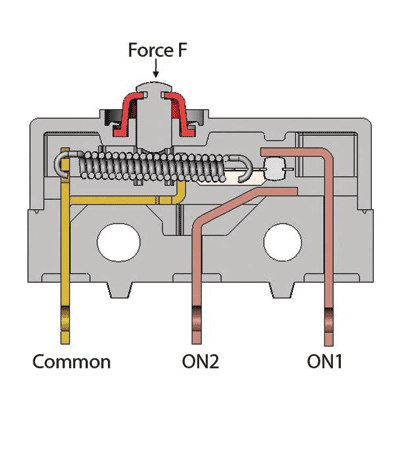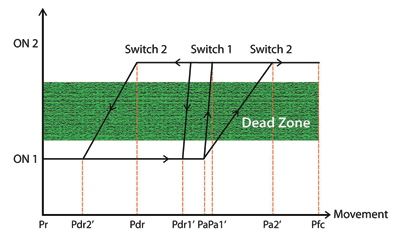The limiting factors of electromechanical switches
Selecting an electromechanical switch for a pressure switch application
BY MARKUS AFFOLTER
Wilbrecht LEDCO
St. Paul, MN
http://www.wilbrechtledco.com
From pharmaceutical to oil and petrochemical industries and many more, process control greatly depends on two physical variables: temperature and pressure. While a wide range of sensors are available for temperature and pressure control in process automation applications, the simplest solution is often an electromechanical switch.
These passive components detect changes in temperature or pressure and open or close a contact when a specified level is reached. The switches directly activate power without requiring an interconnected controller or electronic circuit, delivering an easy-to-use, cost-effective solution for a broad range of applications.
Extreme temperatures and oil vapor or even electromagnetic fields are just some of the difficult conditions that equipment used in the electrical industry must tolerate. Robust pressure or temperature switches based on a mechanical switching mechanism offer several advantages that make them good fits for these environments, including good resistance to electromagnetic disturbances and high temperatures.
High-tech solutions based on MEMS pressure sensors may be less efficient in such an environment. They have limitations in operating temperature normally between 25° and 85°C and are sensitive to electromagnetic fields and humidity. In addition, a change in pressure produces an electrical output signal to be processed or connected to a controller. This means extra components and even software are required to come to a working solution. While mechanical temperature and pressure switches provide the advantages of simplicity, low cost, and durability, there are some disadvantages related to their mechanical design as well.
Principles of measurement
A mechanical switch is activated through deflection of a flexible membrane that divides regions of varying pressure. The deformation of this membrane depends on the difference in pressure between the two faces. The reference face can be open to the atmosphere to measure gauge pressure. To measure differential pressure, the two sides of equal surface area are open to two pressure sources. When one side is open to a sealed volume with a fixed reference pressure, absolute pressure can be measured.
The deforming membrane is placed near the pin plunger of a regular switch. When the pressure is the same on both sides, the switch remains in equilibrium and no action is taken. When the pressure or temperature on one side increases, it causes the membrane to expand outward so that it pushes into the pin. Once the actuating point is reached, the switch commutes from its ON1 position to its ON2 position, beginning the process.
Temperature measurement can be reduced to a pressure measurement when the temperature is guided to a sealed enclosure and used to increase the temperature of the enclosed gas. As described by the universal gas law, pressure is proportional to the temperature of a specific gas. The increase in temperature translates, therefore, into an increase in pressure of the enclosed gas.
Snap-action switches
Many types of switches exist to open or close an electric circuit. Popular varieties include DIP, rocker, toggle, and pushbutton switches, as well as the most commonly used switch in industrial applications or electrical appliances: snap-action switches. For these switches, the change over movement is initiated through an internal spring-loaded pole (see Fig. 1 ). An actuating force is applied on the plunger and transmitted to act on the pole. For activation to occur, the actuating force has to be higher than the internal force, supplied by the spring.

Fig. 1. Snap-action switches are designed to change over from their initial ON1 circuit to their ON2 circuit when the actuating force is higher than the internal force.
Ideally, the switch would instantaneously change over from its ON1 circuit to its ON2 circuit, when the actuating force is higher than the internal force and it reaches the actuating position Pa. In reality, however, mechanical switches are not ideal switches. Instead, the limiting factors of dead-zone passing and switch differential movement (hysteresis) affect the final pressure switch accuracy.
Dead-zone passing
The nature of the game in most process applications is that the pressure build-up is a slow process, so the switch moves gradually from its initial position (Pr) to its actuating position (Pa) and on to its final position (Pfc) (see Fig. 2), and vice-versa. From the time that circuit 1 is opened (Pa) to when the actuating force builds up enough to close circuit 2 (Pa2’), the switch remains in a transition zone, or what is effectively a dead zone.
To activate a process, the actuating force has to increase enough to securely close circuit 2 (ON2). The distance the pin has to travel from the actuating position to a secured position typically exceeds 10 µm for small V4 size switches.

Fig. 2. Since temperature/pressure build-up occurs slowly in most process applications, there is a transition zone between the time when circuit 1 is open and circuit 2 is closed.
Depending on the mechanical construction of the snap action pressure switch, this may represent an important pressure range in which no secure switching can be guaranteed and both electrical circuits remain open. For high-precision applications, switches specifically designed to reduce dead-zone passing to 1 µm are available.
Switch differential movement
As the pressure in the chamber decreases, so does the actuating force — until Pdr is no longer higher than the internal force of the spring. At this point, the switch changes over again, opening circuit 2 (Pdr), passing the dead zone and closing circuit 1 (Pdr2’).
Preferably, the switch would open/close the circuits on the way down at the same points as they were opened/closed on the way up. However, the mechanical resistance on the individual parts causes the switch to commute back not at the actuating position (Pa) but at a later release position (Pdr2’). The distance between the actuating point and the release point is called differential movement, or hystersis, and is critical in accurately detecting small pressure changes.
To maintain optimal switching accuracy for process applications, a switch with low hysteresis should be selected. Many inexpensive, compact V4 switches have a typical hysteresis of 0.15 mm or even more, but switches that consistently reach a differential movement below 0.05 mm are available.
Additional factors
Along with the degree that the limiting factors of dead-zone passing and switch differential movement affect pressure switch accuracy, certain additional characteristics should be considered when selecting a pressure switch. One such factor is the actuating force that is required to cycle the switch. To be able to detect small pressure movements on a small membrane, a low actuating force is needed. Typical actuating forces are between 2 and 6 N, but low actuating force versions exist for forces under 1 N for those applications.
While electromechanical switches are subject to certain limiting factors, when properly selected they can provide an ideal solution for process control applications that rely on temperature and pressure changes. ■
Advertisement
Learn more about Wilbrecht LEDCO





